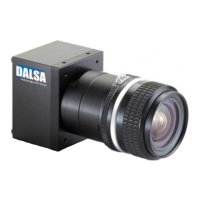Spyder3 GigE Vision User’s Manual
DALSA 03-032-20027-02
45
at only 50% of the DN. An analog gain of 6 dB (2x) will ensure full use of the
dynamic range of the A/D converter. Of course the noise is also increased. Note: To
maintain valid LUT calibration, do not use the
GainAbs command with the 4k
model. Instead, use the DigitalGainRaw command.
2. The analog offset (BlackLevelRaw command) or black level is an “artificial” offset
introduced into the video path to ensure that the A/D is functioning properly. The
analog offset should be set so that it is at least 3 times the rms noise value at the
current gain.
Digital Processing
To optimize camera performance, digital signal processing should be completed after any
analog adjustments.
1. Fixed pattern noise (FPN) calibration (calculated using the
CorrectionCalibrateFPN command) is used to subtract away individual pixel
dark current.
2. The digital offset (
DigitalOffsetRaw command) enables the subtraction of the
“artificial” A/D offset (the analog offset) so that application of the PRNU coefficient
doesn’t result in artifacts at low light levels due to the offset value. You may want to
set the
DigitalOffsetRaw value if you are not using FPN correction but want to
perform PRNU correction.
3. Photo-Response Non-Uniformity (PRNU) coefficients (calculated using the
CorrectionCalibratePRNU or CalculatePRNUAlgorithmTargetValue commands)
are used to correct the difference in responsivity of individual pixels (i.e. given the
same amount of light different pixels will charge up at different rates) and the change
in light intensity across the image either because of the light source or due to optical
aberrations (e.g. there may be more light in the center of the image). PRNU
coefficients are multipliers and are defined to be of a value greater than or equal to 1.
This ensures that all pixels will saturate together.
4. Background subtract (
SubtractBackgroundRaw command) and system (digital)
gain (
DigitalGainRaw command) are used to increase image contrast after FPN and
PRNU calibration. It is useful for systems that process 8-bit data but want to take
advantage of the camera’s 12 bit digital processing chain. For example, if you find
that your image is consistently between 128 and 255DN(8 bit), you can subtract off
128 (
SubtractBackgroundRaw 2048) and then multiply by 2 (DigitalGainRaw
8192) to get an output range from 0 to 255.
Analog Signal Processing: Setting Analog Gain and
Offset
All analog signal processing chain commands should be performed prior to FPN and
PRNU calibration and prior to digital signal processing commands.
Note: This command will invalidate the LUT calibration for the 4k model of camera. Use
the
DigitalGainRaw command instead.
Setting Analog Gain

